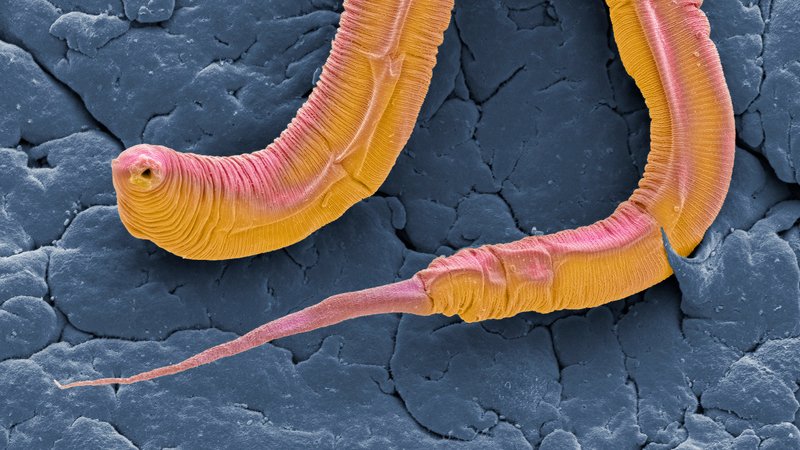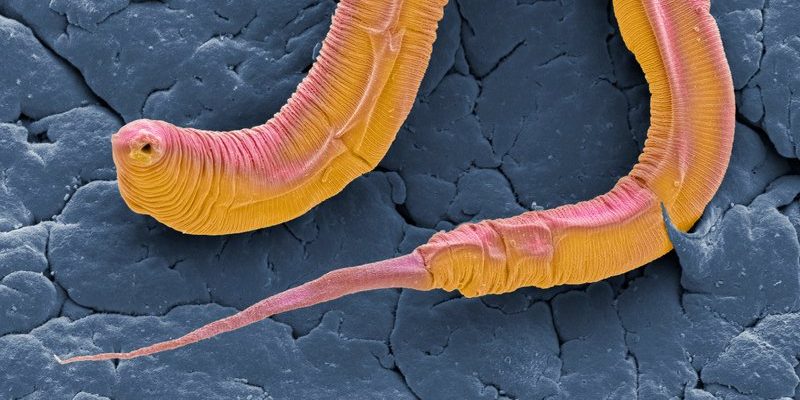
Roundworms are like the unsung heroes of the soil; they help decompose organic material, aerate the ground, and even contribute to nutrient cycling. Think of them as nature’s recyclers, breaking down waste and returning valuable nutrients to the earth. They can be as tiny as a pinhead or as long as several meters, and they come in a variety of shapes and sizes. Let’s dive deeper into understanding what these remarkable creatures are all about.
What Are Roundworms?
Roundworms, or nematodes, are a type of unsegmented worm characterized by their long, cylindrical bodies. They can be found in nearly every environment on Earth, from the soil in your backyard to the depths of the ocean. Estimates suggest that there are over 25,000 described species of roundworms, but many more remain undiscovered. Their body structure is quite simple, allowing them to thrive in diverse habitats.
What sets roundworms apart is their unique reproductive system. Most species reproduce via sexual reproduction, but some can also self-fertilize. This adaptability allows them to flourish even in challenging environments. For instance, when conditions are tough, such as during droughts, some roundworms can enter a state called cryptobiosis, essentially suspending their life processes until conditions improve. Isn’t that wild?
Types of Roundworms
There are two main categories of roundworms: free-living and parasitic.
- Free-living roundworms: These nematodes thrive in soil, freshwater, and marine environments. They contribute to soil health by feeding on bacteria, fungi, and organic particles. An example is *Caenorhabditis elegans*, a model organism used extensively in biological research due to its simple structure and well-understood genetics.
- Parasitic roundworms: These sneaky little guys infect plants, animals, and humans. Some well-known parasitic roundworms include hookworms, which can latch onto the intestines of mammals, and the infamous Ascaris lumbricoides, which thrives in humans. These parasites can cause serious health issues, making them a significant concern in many parts of the world.
Understanding these categories helps highlight the diverse lifestyles of roundworms and their varying impacts on ecosystems and human health.
The Role of Roundworms in Ecosystems
Roundworms play a vital role in maintaining ecosystem balance. They contribute to soil fertility by breaking down organic matter. When they feed on decaying plant material, they help release nutrients back into the soil, making them available for plants. This process is crucial for healthy plant growth and, by extension, a thriving ecosystem.
They also participate in the food web. Many larger organisms, like birds, frogs, and even some mammals, rely on roundworms as a food source. By providing sustenance for these animals, roundworms indirectly support biodiversity. When you think about it, they’re the little guys keeping the whole system running smoothly!
Moreover, some researchers are studying roundworms for their potential medicinal benefits. Certain species have compounds that might help in developing new drugs. So, roundworms are not just important for the environment, but they could also play a role in our health. That’s pretty impressive for such tiny creatures!
How Roundworms Reproduce
Roundworm reproduction is quite fascinating. Most roundworms have separate sexes—males and females—though some are hermaphroditic, meaning they possess both reproductive organs. During mating, males typically use their spicules (tiny, hook-like structures) to hold onto the female while transferring sperm.
After fertilization, females lay hundreds to thousands of eggs, which can then develop into larvae within a few days. The life cycle can vary significantly between species, with some larvae emerging ready to infect a host, while others develop in the soil. This adaptability in reproduction allows roundworms to thrive in various environments and conditions, ensuring their survival across generations.
It’s interesting to think about how these reproductive strategies have evolved. They’ve found ways to persist and adapt that some larger organisms may not necessarily have.
Roundworms and Human Health
While many roundworms are beneficial, some can pose significant health risks to humans. Parasitic roundworms, such as Ascaris lumbricoides and hookworms, can cause a range of health issues, particularly in developing countries. These parasites can lead to malnutrition, anemia, and other serious conditions when left untreated.
Infections usually occur via contaminated food or water sources. This means that practicing good hygiene and sanitation is crucial for prevention. Education on how to avoid these infections can significantly reduce their prevalence in at-risk communities.
On a lighter note, did you know that scientists are even exploring the use of roundworms in drug development? Some nematodes produce compounds that may have therapeutic potential, leading to exciting advancements in medicine. So, in this sense, roundworms might be more beneficial to us than we originally thought!
Common Misconceptions About Roundworms
There are several myths surrounding roundworms, and it’s time to clear the air. One common misconception is that all roundworms are harmful. As we’ve discussed, while some species are parasitic, many are harmless and even beneficial to ecosystems. Another myth is that roundworms are only found in dirty or contaminated areas, but in reality, free-living roundworms can thrive in clean, healthy environments too.
People often also confuse roundworms with other types of worms like earthworms or flatworms. While they all share certain characteristics, they belong to different groups with distinct biological traits. Understanding these differences can help you appreciate these little critters more.
Here’s the thing: education is key. The more we understand about roundworms, the better we can manage and protect our environments, as well as our own health.
So, what have we learned about roundworms? They may be small and often overlooked, but they have a substantial impact on our ecosystems and even human health. From their diverse habitats to their fascinating reproductive strategies and roles in nutrient cycling, roundworms truly deserve a place in our naturalist’s heart.
Next time you dig in the garden or take a walk in nature, take a moment to appreciate these tiny creatures. They’re working behind the scenes, maintaining balance and health in our ecosystems. Who knew that such small beings could play such big roles?

